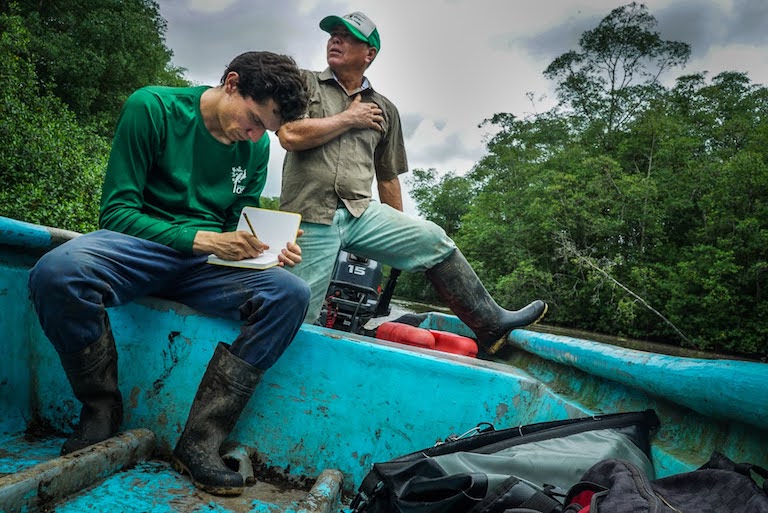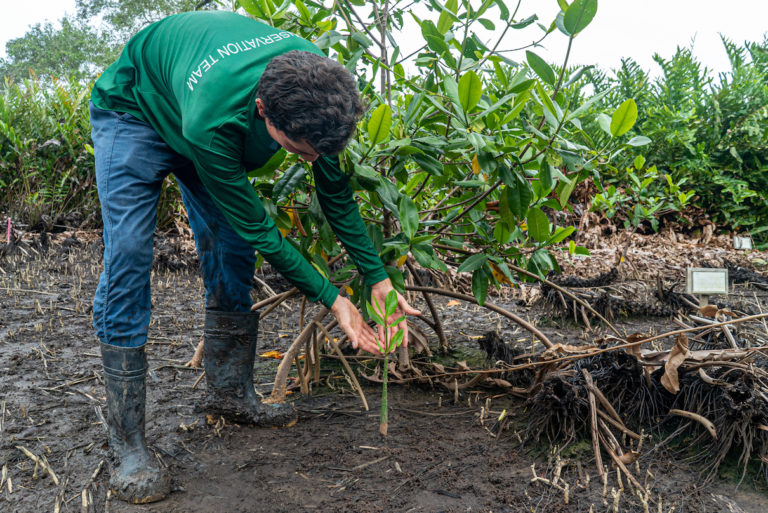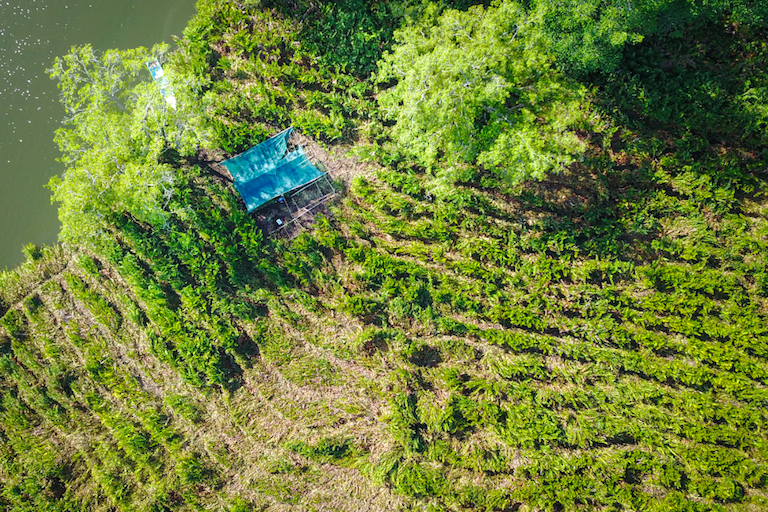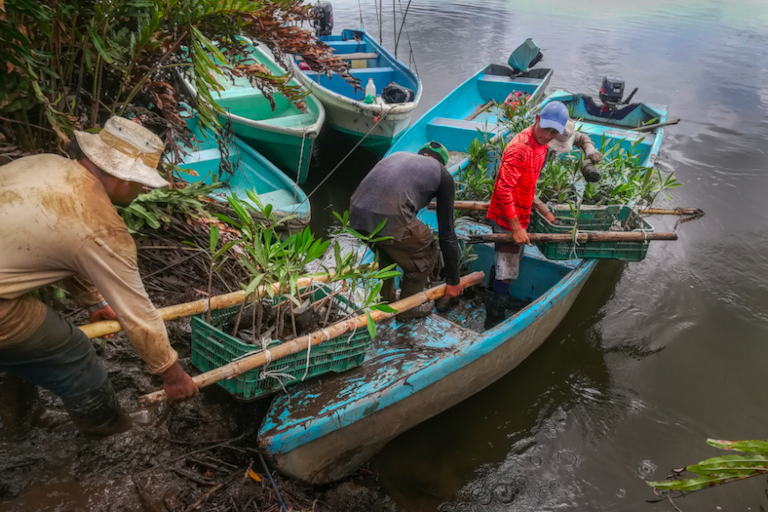Restoring mangroves in Costa Rica has revitalized local economies
The pioneering forest-based payment schemes in Costa Rica that reimburse landowners who protect local ecosystems, has helped double the country’s forest cover. Adrián Torres is one of the success stories. Twenty years ago he made his living by destroying mangroves, now he’s helping work towards a more sustainable future.
T
wenty years ago, I collected between 600 to 800 a day – now I’m lucky if I can harvest 150.” Adrian Torres holds a black, shining, wrinkled mollusk (Anadara tuberculosa) the size of a small chicken egg. It is known as the “mud cockle,” or here along Costa Rica’s Pacific coast, as the piangua.
That’s why Adrian and the members of his community association, Ajuntaderas, are known as the “piangueros” – the mud cockle collectors. They live within the Terraba Sierpe National Wetland, one of the largest protected wetlands in Central America. For as long as Adrian can remember, his community – and others living nearby – have depended upon the harvest of this gothic looking shellfish to make their living; a practice that replaced the harvesting of timber from the wetland’s mangrove trees.
The piangua depends on the mangroves, especially red mangroves of the genus Rhizophora. The tree’s stilt roots in the muddy banks and its tolerance to salinity and high tides make for the perfect piangua home. But the mollusk population is not quickly replenished. Research agrees with Adrian that over-harvesting is driving catch numbers down, and the average size of the shells is getting smaller – no surprise considering that pianguas take over 25 years to reach full size.

Adrián Torres, President of the Association of Piangueros and Javier Rodríguez, from the National University and Mangrove Restoration Coordinator at Osa Conservation. Photo by Lucy Kleiner for Osa Conservation.
Both pianguas and mangroves became especially valuable to rural coastal communities following the collapse of Costa Rica’s banana boom in the 1980’s. In the decades that followed, Costa Rica lost more than 25,000 hectares of mangroves – about 40% of the country’s total – as the timber was a main income source for local communities.
“I helped a lot to destroy the wetlands,” Adrian says. “There were areas that we left with absolutely nothing.”
This rapid destruction reflects the international pattern of mangrove loss. Between 30% to 50% of the world’s mangroves have been depleted in less than a century, making mangroves one of the most threatened tropical ecosystems. Despite this, a mere 6.9% of the world’s mangrove wetlands are well protected.
Fortunately, in 1994, the Terraba Sierpe National Wetland – the largest mangrove system in Costa Rica – became a part of this small percentage. An area containing more than a third of Costa Rica’s mangroves, the piangueros dependence on the edible bivalve became even stronger.

Javier Rodríguez with new sprouting mangroves planted 2.5 years ago. Photo by Lucy Kleiner for Osa Conservation.
We weave through the winding channels of the mangroves. Then Adrian steers his small motorboat toward the bank. Pointing, he says, “That’s one of the areas where we cleared the mangroves.” Ahead are a couple of lone remnant trees, of which the lower trunks we cannot see due to the thicket-wall of three-meter-tall ferns.
This fern (Acrostichum aureum) has a pan-tropical distribution and can be found naturally within mangrove ecosystems throughout the tropics. Typically, the ferns’ dominance is kept in check by the mangroves and only small pockets exist between the trees and narrow channels. But when the mangroves were cleared 30 to 40 years ago, the sun-loving fern established aggressively and gave no chance for young mangrove trees to regrow. These swathes of fern have been there ever since.
In the boat with us is Javier Rodriguez-Gonzalez, a forestry expert from the National University of Costa Rica and leader of the mangrove restoration project from Osa Conservation. “Over 2,000 hectares of this huge, 20,000-hectare wetland is dominated by the fern — areas that were cleared for firewood, posts, and tannins,” Javier tells me. “Our goal — if we can develop the right techniques — is to see the rich carbon stores of mangrove trees restored and brimming with biodiversity.”
They’re starting small — so far 30 hectares have been restored as part of the pilot-project. But the goal is to deliver clear results to government agencies, and the private sector, outlining the most efficient ways to simultaneously restore mangroves and stimulate local economies. Success would mean a win for the environment, and a win for the communities.
“We’re developing a tool,” Javier says, “so that our techniques can be used to restore mangrove ecosystems throughout this wetland, the country’s wetlands, and if we get this right, throughout Central America.”
A fresh start
Two years previously, we all visited the restoration site, joined by over 20 community members, scientists from the national university, the local mayor, German funders of the project, and representatives from the protected area management agency. The ceremony marked the first planting day of a three-year trial to develop and test techniques to remove the aggressive fern and see how, if at all, the mangroves might be re-established.
As I stepped out of that boat from the intense, blinding sun into the darkness below the arching fronds of the fern, I had little hope for the 30-centimeter-tall sapling I carried in my hand.
A few meters in from the bank however, the community members had completely cleared an area of the fern – by hand with machetes, knee-deep in mud – to create one of the test plots where the attendees would plant our mini salt-loving trees.
Today, Javier, Adrian, and I were returning to see if the pilot restoration trials were working, or not.

Mangrove restoration plot where ferns are cleared in rows for mangroves to be planted. Photo by Lucy Kleiner for Osa Conservation.
Mangrove restoration plot where ferns are cleared in rows for mangroves to be planted. Other methods include circular plots and plots completely cleared of ferns. Photo by Lucy Kleiner for Osa Conservation.
I was relieved to see that not only were many of the tiny saplings alive but facing me at eye level, and I’m over six-feet tall. Even more exhilarating were the flowers blooming on our two-and-a-half-year-old trees, and the seeds now germinating, established naturally at the foot of the young trees. The community had done an incredible job in maintaining and clearing back the fern.
Over 28,000 new mangroves have been planted across the 30 hectares. We visited various sites where Javier, Adrian and the community had tested different techniques – labor intensive clearing, cutting of two-meter-wide strips through the fern wall, different mixes of mangrove species, and more – all to determine the best route to success and efficiency.
“It’s working,” says Javier. “We weren’t sure that it would, due to the aggressive-nature of the fern and the rapid regeneration from its rhizomes, but the communities have been dedicated and the mangroves are more resilient than we first thought – they just need a helping hand to get started.”

Community members sink into mud while hauling crates of young mangrove saplings to the boat. Photo by Lucy Kleiner for Osa Conservation.
A sustainable solution
Adrian tells me about the field work. “It’s tough, but we know how to get it done, and it provides us with a new income. In addition, all the time we spend collecting seeds, clearing the fern, and doing maintenance means we are harvesting fewer pianguas.”
Now more than ever, the piangueros need alternatives to unsustainable economic returns from bananas, logging, and – if an over-intensive harvest continues – a locally extinct bivalve.
The only other opportunities in the region for those not suited to eco-tourism (that itself is fragile as we have seen in the global tourism collapse related to Covid-19) is working in the pesticide-intense monocultures of pineapple or oil palm. Not only damaging to nature, they are dangerous to the workers’ health.
So far, everyone involved in the pilot mangrove restoration scheme benefits – both nature and people. Instead of communities within the region degrading biodiversity, the protected area’s managers have community neighbors that are encouraged to improve the overall health of the ecosystem that they depend upon.
Despite the careful start, the opportunity isn’t small. Should the whole 2,000 plus hectares of dense fern within the protected area be opened up for restoration, and funded by a blue carbon market, employment could be generated for Ajuntaderas and at least two other communities for the next two to three decades – a real nature-based employment opportunity.
“Communities could receive up to roughly $1,500 per hectare to restore mangroves,” says Udo Censkowsky from Blue Sensus Sustainability, “And they could easily do 100 hectares per year with the techniques being developed. That was part of the key focus of this pilot project, to calculate what the real cost of doing this here in Costa Rica was, and to see if market values were within a feasible range for this to be an attractive opportunity for people on the ground. It appears that it is – and now we need to figure out the mechanics of making this happen.”
Investing in mangrove restoration makes sense from every angle. Communities can earn stable incomes that stimulate the economy. Mangrove restoration efforts are far more affordable than other marine coastal restoration projects, and their carbon sequestration potential is unparalleled throughout the tropics. Plus, the flood protection provided by mangroves can more than pay for itself.
The real challenge in building such a scheme is doing so inside a protected area on national land. Costa Rica’s pioneering forest-based payment for ecosystem service schemes have helped to double the country’s forest cover over the past three decades – much of which is on private lands. As the impressive Terraba del Sierpe Wetland is a protected area, Costa Rica would first need a framework and a mechanism to permit blue carbon-supported restoration inside the park.
Investment for a greater return
We finish our visit at Adrian’s home, where he invites me to try fresh piangua.
He grabs one of the cockles from the morning’s catch. Thanks in part to Adrian’s leadership, there are new restrictions that protect the sustainability of piangua extraction. There is now a suggested cap on the number of pianguas harvested per community member annually, as well as a size limit on the bivalves. Adrian shows me the calipers he uses, set at the 47mm minimum size to measure the shells he collects. “Anything smaller is returned, hopefully for the future.”
He lines the shell carefully on a file clamped to a block of timber and smacks it forcefully with a metal baton along the back joint – so not to shatter the shell. He squeezes fresh lemon juice onto the meaty clam lying in black, salty juice and hands it to me. It’s freshly delicious.
“At the moment, I can sell my morning’s catch of 100 pianguas for about $11. That can easily make over 14 portions of ceviche, with a value in the restaurants of more than $100.” Someone is making a good profit from the pianguas, but it doesn’t seem to be the piangueros.
Local piangueros rise with the sun to extract pianguas from the mangrove habitat in the morning low tide. Photo by Lucy Kleiner for Osa Conservation.
With the funds the community association has earned from the pilot restoration work so far, they have purchased a lot of land to build a collection and processing center for pianguas. This will allow the community to sell their produce for a higher value because of better facilities for processing and storage. It’s a sign of commitment by the community to reinvest in their livelihoods, and use their resources in a sustainable way.
“When I was growing up, the mangroves were not valued, but now they are,” Adrian tells me. “If we can keep working to restore mangroves and remove the fern, reduce our pressures on the pianguas, and continue to re-invest what restoration can bring us – then I believe we have a sustainable plan ahead.”
The ideas presented in this article aim to inspire adaptation action – they are the views of the author and do not necessarily reflect those of the Global Center on Adaptation.